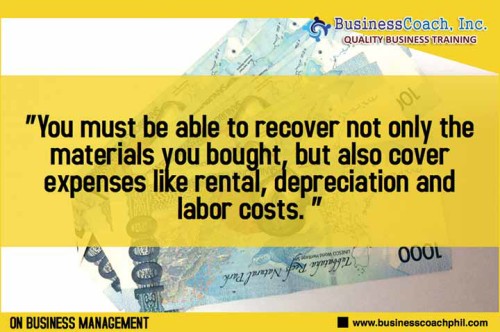Landlines: (02) 8.727.56.28 / (02) 8.569.78.84 /
(02) 8.569.46.90 / (02) 8.727.88.60
Mobile Nos: Globe: 0915.205.0133 / Smart: 0908.342.3162 / Sun: 0933.584.7266
The Seven Common Pricing Mistakes
Of all the components of the marketing mix, pricing is the most neglected. This is a common mistake made by many entrepreneurs because despite everything, price is the primary determinant of sales and profits. To a large extent, your company’s strategy and physical appearance are affected by your pricing decision.
The truth is, figuring the best price to sell your product or service is no simple task. In fact, many books have been written on this topic alone. To be able to offer useful advice, I am constrained to limit our discussion only to the worst pricing bloopers usually committed by entrepreneurs:
• Adopting the going rate. The majority of businessmen choose this option because it is considered a safe choice. Going with the general market price, many think, is a great short cut because your competitors are unlikely to sell at a loss. However, this is not always the case. It is possible that they are able to obtain supplies at a far lower cost and you may suffer a loss if you copy their price. On the other hand, there may be compelling reasons why you should price higher; your quality and service may be superior and a premium price is justified.
• Neglecting to cost in your overhead. You must be able to recover not only the materials you bought, but also cover expenses like rental, depreciation and labor costs. Going through all the expenses that make up your total cost with an accountant is time and money well spent.
• Engaging in a price war. Rarely is this a wise choice for an entrepreneur, as everyone loses in a price war. You must have a lot of reserve capital to sustain this strategy, and most of the time it is not the ideal course. In case you find yourself being attacked by a price-cutting competitor, a better strategy is to differentiate your product or to launch a lower cost brand.
• Refusing to lower prices when necessary. There are times when you need to lower the price even below cost in order to make the item move. But many would not sell below their cost, preferring to wait for months or years to dispose the item. This results in capital being tied unproductively, besides incurring storage costs. Another bad side effect of this is that your customers will not like being offered shop-worn and passé items.
• Forgetting to factor in taxes. There are many taxes that must be paid, and you must take them into account when setting your price. The most important tax to consider is the value added tax or VAT because, unless you are VAT-exempt, this must be paid even if you do not make a profit.
• Applying the same mark-up across all items. If you carry a lot of inventory, you must take the time to study the best markup for each of them. One tip I can give you is to price competitively on fast-moving items. I know some retailers that have a reputation for low prices, when in fact they are low on only a handful of popular items.
• Neglecting to continuously monitor market prices. While I advised not blindly copying the going market rates, ignoring it is a worse blunder. You must always be vigilant in checking the prices of competitors. Having this knowledge early will give you more time to plan how to react before too much damage to your sales is done.
Pricing is the most potent variable in marketing that you can easily control. The pricing policy you adopt can make or break your business. As you realize its importance, it will be wise idea to ponder your current pricing strategy.
*Originally published by the Manila Bulletin. Written by Ruben Anlacan, Jr. (President, BusinessCoach, Inc.) All rights reserved. May not be reproduced or copied without express written permission of the copyright holders.
You might also like:
The Vital Role of the Business Model »
Starting a Business While Still Employed »
Business Lessons from Sun Tzu »
How to develop a good personal brand »
Myths About Starting a Business »



